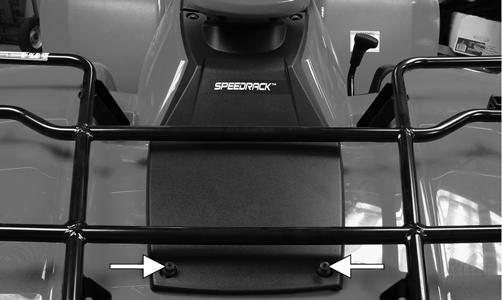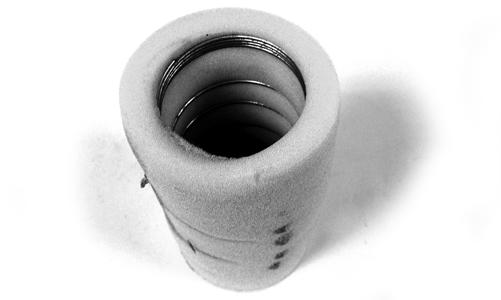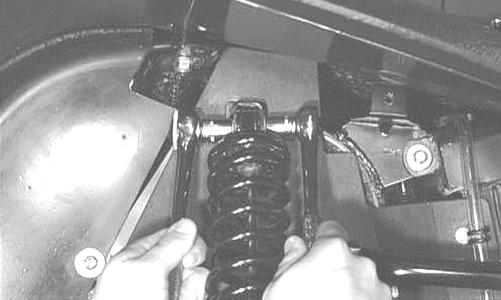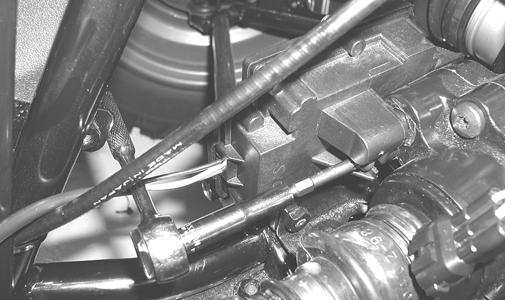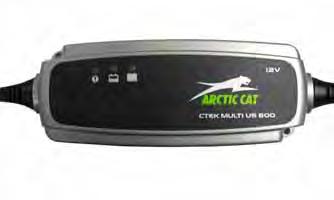
15 minute read
Fuel/Lubrication/Cooling
NOTE: Arctic Cat recommends the use of new gaskets, lock nuts, and seals and lubricating all internal components when servicing the engine/transmission.
SPECIAL TOOLS
A number of special tools must be available to the technician when performing service procedures in this section. Refer to the current Special Tools Catalog for the appropriate tool description.
Description
Oil Pressure Test Kit Seal Removal Tool Tachometer p/n
0644-495 0644-072 0644-275
NOTE: Special tools are available from the Arctic Cat Service Department.
TROUBLESHOOTING
1. Verify that the electric fuel pump is operating by listening for a “whirring” sound for several seconds after the ignition switch is turned to the ON position.
If no sound can be heard, see Electric Fuel
Pump/Fuel Level Sensor in this section. 2. Check for a flashing DTC (Diagnostic Trouble
Code) on the LCD. If a code is flashing, see appropriate Diagnostic Trouble Codes (DTC) in Electrical
System. 3. Make sure there is sufficient, clean gas in the gas tank. 4. Verify that the battery is sufficiently charged to crank the engine over at normal speed. 5. Check the air filter housing and air filter for contamination. Clean or replace as necessary (see Periodic
Maintenance).
Throttle Body
! WARNING
Whenever any maintenance or inspection is performed on the fuel system during which there may be fuel leakage, there should be no welding, smoking, open flames, etc., in the area.
REMOVING (500/550/700)
1. Turn the ignition switch to the OFF position; then remove the ignition switch key. 2. Remove the seat; then disconnect the battery. 3. Remove the storage compartment cover and air filter housing cover; then remove the air filter. 4. Loosen the clamp securing the air filter housing boot to the throttle body inlet; then remove the boot from the throttle body. 5. Slowly disconnect the gasline hose connector from the fuel rail.
! WARNING
Do not turn the ignition switch to the ON position with the hoses removed. Gasoline will be pumped by the electric fuel pump causing a safety hazard. ! WARNING
Gasoline may be under pressure. Place an absorbent towel under the connector to absorb any gasoline spray when disconnecting.
FI092A 6. Remove the screw securing the throttle actuator cover to the throttle body; then remove the cover. 7. Remove the throttle cable from the actuator arm.
8. Loosen the outer jam nut securing the throttle cable to the throttle body; then route the cable out of the way. 9. Remove the MAP sensor (A), fuel injector connector (B), ISC connector (C), and TPS connector (D).

HDX136A 10. Remove the cap screws securing the intake pipe to the cylinder head and remove the throttle body assembly; then remove the intake pipe from the throttle body. Account for an O-ring.

FI104A
11. Use tape to cover and seal the intake opening.
CAUTION
Any objects or liquid entering the intake opening will fall into the engine causing severe damage if the engine is turned over or started.
REMOVING (1000)
! WARNING
Whenever the gasline hoses are removed (other than for pressure testing), the battery must be disconnected to prevent inadvertent activation of the electronic fuel pump.
1. Remove the front rack and body panel. 2. Disconnect the wires from the IAT sensor; then loosen the clamp and remove the inlet air boot from the air filter housing.

GZ379 3. Loosen the clamp on the throttle body intake boot; then remove the air filter housing from the ATV. 4. Disconnect the three wiring connectors from the sensors on the throttle body; then remove the cap screws securing the throttle body to the intake manifold.


GZ094B

GZ381A 5. Remove the throttle arm cover and disconnect the throttle cable; then remove the throttle body from the
ATV.

GZ383A
6. Use tape to cover and seal the intake opening.
CAUTION
Any objects or liquid entering the intake opening will fall into the engine causing severe damage if the engine is turned over or started.
INSTALLING (500/550/700)
1. Install the throttle body into the intake pipe and secure with the clamp. Tighten securely.
2. Place a new O-ring in the intake pipe; then position the pipe onto the engine and secure with two cap screws. 3. Connect the throttle cable to the throttle body and adjust throttle cable free-play (see Throttle Cable
Free-Play in this section); then connect the gasline hose. 4. Connect the four electrical connectors to the throttle body components. 5. Install the air filter housing boot and secure with the clamp; then install the air filter, air filter cover, storage compartment, and storage compartment cover. 6. Connect the battery (positive cable first); then install the seat making sure it locks securely in place. NOTE: If the throttle body, ECM, TPS, or ISC are replaced, the EFI system must be synchronized. Use the following procedure.
1. With the key off, depress accelerator pedal to Wide
Open Throttle (WOT). 2. Place the ignition key in the ON position and wait for 10 seconds. 3. Release the accelerator pedal, and wait an additional 10 seconds. 4. Turn the key to the OFF position and allow the gauge to shut off.
INSTALLING (1000)
1. Connect the throttle cable to the throttle body; then remove the tape from the intake manifold and install the throttle body using a new O-ring. Tighten the cap screws securely.

GZ381A 2. Connect the three wiring connectors to the sensors; then install the air filter housing and connect all hoses. Tighten all clamps securely.

GZ094B

GZ091A 3. Connect the wiring connector to the IAT sensor. 4. Install the front rack and body panel. 5. Install the seat making sure it locks securely in place. NOTE: If the throttle body, ECM, TPS, or ISC are replaced, the EFI system must be synchronized. Use the following procedure.
1. With the key off, depress accelerator pedal to Wide
Open Throttle (WOT). 2. Place the ignition key in the ON position and wait for 10 seconds. 3. Release the accelerator pedal, and wait an additional 10 seconds. 4. Turn the key to the OFF position and allow the gauge to shut off.
Throttle Cable Free-Play
To adjust the throttle cable free-play, follow this procedure. 1. Slide the rubber boot away; then loosen the jam nut from the throttle cable adjuster.

AL611D 2. Turn the adjuster until the throttle cable has proper free-play of 3-6 mm (1/8-1/4 in.) at the lever.

CF297A 3. Tighten the jam nut against the throttle cable adjuster securely; then slide the rubber boot over the adjuster.
Engine RPM (Idle)
NOTE: The idle RPM is not adjustable on the EFI models.
Gas Tank
! WARNING
Whenever any maintenance or inspection is made on the fuel system during which there may be fuel leakage, there should be no welding, smoking, open flames, etc., in the area.
REMOVING
1. Remove the seat. 2. Remove the rear rack and fenders (see Steering/Frame/Controls). 3. Disconnect the hose from the fuel pump to the throttle body by compressing the release on the connector.

FI092A 4. Remove the cap screws securing the gas tank to the frame. 5. Disconnect the fuel gauge connector; then remove the gas tank. CLEANING AND INSPECTING
1. Clean all gas tank components with parts-cleaning solvent. 2. Inspect all hoses for cracks or leaks. 3. Inspect tank cap and tank for leaks, holes, and damaged threads. 4. Remove the fuel level sensor/fuel pick-up assembly and inspect the fuel level sensor and fuel screen. NOTE: If the fuel level sensor has failed or may be faulty, see Electric Fuel Pump/Fuel Level Sensor in this section.
INSTALLING
1. Install the fuel level sensor/fuel pick-up assembly. 2. Place the gas tank into position in the frame; then install the cap screws. Tighten securely. 3. Connect the gasline hose from the throttle body; then connect the fuel gauge connector. 4. Fill the gas tank with gasoline. 5. Start the engine and inspect for leakage. 6. Install the rear fenders and rack (see Steering/Frame/Controls); then install the seat making sure it latches securely.
Oil Filter/Oil Pump
NOTE: Whenever internal engine components wear excessively or break and whenever oil is contaminated, the oil pump should be replaced. The oil pump is not a serviceable component.
Testing Oil Pump Pressure
NOTE: The engine must be warmed up to the specified temperature for this test.
1. Connect the Tachometer to the engine or utilize the
LCD (if equipped). 2. Connect the Oil Pressure Test Kit to the oil pressure test port (500/550/700) or the oil cooler to oil filter line (1000).
550/700
500

CF264C
1000

KC370A 3. Start the engine and run at 3000 RPM. With the oil temperature at 60° C (140° F), the oil pressure gauge must read as specified.
500
550/700
1000 0.6-0.7 kg/cm2 (8.5-10 psi) 1.2-1.5 kg/cm2 (17-21 psi) 1.05-1.2 kg/cm2 (15-17 psi)
NOTE: If the oil pressure is lower than specified, check for low oil level, defective oil pump, or restricted oil cooler (1000).
NOTE: If the oil pressure is higher than specified, check for too heavy engine oil weight (see General Information), clogged oil passage, clogged oil filter, or improper installation of the oil filter.
Oil Cooler (1000)
REMOVING
NOTE: It is not necessary to drain the engine oil for this procedure.
1. Remove the input and output hoses from the fittings on the cooler.
2. Remove the cap screws securing the oil cooler to the frame. Account for grommets. 3. Remove the oil cooler from the frame.
CAUTION
Elevate and secure the hoses to avoid oil spillage.
INSTALLING
1. Place the cooler into position in the frame. 2. Secure the cooler to the frame with the cap screws and grommets. 3. Install the hoses onto their respective fittings and secure with the clamps.
GZ118A

NOTE: Some oil seepage may occur when installing the oil pressure gauge. Wipe up oil residue with a cloth.
Oil Flow Chart

500/550/700
oil_flow_wt
Liquid Cooling System

When filling the cooling system, use premixed Arctic Cat Antifreeze. While the cooling system is being filled, air pockets may develop; therefore, run the engine for five minutes after the initial fill, shut the engine off, and then fill the cooling system to the bottom of the stand pipe in the radiator neck.
CAUTION
After operating the ATV for the initial 5-10 minutes, stop the engine, allow the engine to cool down, and check the coolant level. Add coolant as necessary.
RADIATOR
Removing

1. Drain the coolant at the engine. 2. Remove the front rack (see Steering/Frame/Controls). 3. Remove the front bumper and front fender panel (see
Steering/Frame/Controls). 4. Remove the upper and lower coolant hoses. 5. Remove the cap screws and nuts securing the radiator to the frame. 6. Disconnect the fan wiring from the main wiring harness; then remove the radiator/fan assembly and account for the grommets and collars. 7. Remove the fan/fan shroud assembly from the radiator.
oil_flow_H2
1. Flush the radiator with water to remove any contaminants. 2. Inspect the radiator for leaks and damage. 3. Inspect all hoses for cracks and deterioration. 4. Inspect all fasteners and grommets for damage or wear. Installing
1. Position the fan/fan shroud assembly on the radiator; then secure with existing hardware. 2. Place the radiator with grommets and collars into position on the frame; then install the cap screws and nuts. Tighten securely. 3. Install the upper and lower coolant hoses; then secure with hose clamps.

AF734D 4. Install the front bumper and front fender panel (see
Steering/Frame/Controls). 5. Install the front rack (see Steering/Frame/Controls). 6. Fill the cooling system with the recommended amount of antifreeze. Check for leakage. 7. Connect the fan wiring to the main wiring harness. THERMOSTAT
Removing (500/550/700)
1. Drain approximately one quart of coolant from the cooling system. 2. Remove the two cap screws securing the thermostat housing to the cylinder head. Account for an O-ring and a thermostat.
Removing (1000)
NOTE: The thermostat is located in a housing in-line with the upper radiator hoses under the air filter housing.

GZ036A 1. Drain approximately one quart of coolant from the cooling system. 2. Remove the machine screws securing the thermostat housing together. Remove the thermostat and account for an O-ring. Inspecting
1. Inspect the thermostat for corrosion or spring damage. 2. Using the following procedure, inspect the thermostat for proper operation.
A.Suspend the thermostat in a container filled with water.
B.Heat the water and monitor the temperature with a thermometer.
C.The thermostat should start to open at 71-86° C (160-187° F).
D.If the thermostat does not open, it must be replaced. 3. Inspect all coolant hoses, connections, and clamps for deterioration, cracks, and wear.
NOTE: All coolant hoses and clamps should be replaced every four years or 4000 miles.
Installing (500/550/700)
1. Place the thermostat and O-ring into the thermostat housing; then secure the thermostat housing to the cylinder head with the two cap screws. 2. Fill the cooling system with the recommended amount of antifreeze. Check for leakage. Installing (1000)
1. Place the thermostat and O-ring into the thermostat housing; then secure the thermostat housing together with the machine screws. 2. Fill the cooling system with the recommended amount of antifreeze. Check for leakage.
Removing
1. Remove the radiator (see Radiator in this sub-section). 2. Remove the fan assembly from the radiator. Installing
1. Position the fan assembly on the radiator; then secure with existing hardware. NOTE: The fan wiring must be in the upper-right position.
2. Install the radiator.
WATER PUMP (500/550/700)
NOTE: The water pump is a non-serviceable component. It must be replaced as an assembly.
Removing
1. Remove the radiator cap; then remove the water pump drain and drain the coolant.

CC789
2. Drain the oil from the engine/transmission. 3. Remove the four torx-head cap screws securing the front and rear fenders to the footrest; then remove the four cap screws securing the footrest to the frame.
Remove the footrest. 4. Loosen the hose clamps and slide the clamps away from the hose ends approximately 2 in.; then remove both hoses from the water pump. 5. Using an impact driver, loosen but do not remove the two Phillips-head cover screws.

CC785A 6. Remove the two cap screws securing the water pump to the engine; then remove the water pump.

CC786A
Installing
1. Secure the water pump to the engine with the two cap screws tightened securely; then tighten the two
Phillips-head cover screws securely.
CC786A

CC785A 2. Connect the two coolant hoses to the water pump and secure with the clamps. Tighten securely. 3. Place the footrest into position on the frame and loosely secure with four cap screws; then secure the front and rear fenders to the footrest with the four torx-head cap screws. Tighten the four torx-head cap screws securely; then tighten the 8 mm cap screws to 20 ft-lb and the 10 mm cap screws to 40 ft-lb. 4. Fill the engine/transmission with the proper amount of recommended oil. 5. Fill the cooling system with the proper amount of recommended coolant.
NOTE: While the cooling system is being filled, air pockets may develop; therefore, run the engine for five minutes after the initial fill, shut the engine off, and then fill the cooling system.
6. Check the entire cooling system for leakage.
CAUTION
After operating the ATV for the initial 5-10 minutes, stop the engine, allow the engine to cool down, and check the coolant level. Add coolant as necessary.
WATER PUMP (1000)
NOTE: The water pump is a non-serviceable component. It must be replaced as an assembly.
Removing
1. Remove the coolant drain plug; then remove the radiator cap and drain the coolant into a suitable container.

NOTE: Always use a large container and have sufficient floor drying material available when draining the coolant in case of coolant spillage.
2. Remove the coolant hoses from the water pump; then remove two cap screws securing the water pump to the crankcase.

GZ230A
3. Remove the water pump from the engine. Installing
1. Install a new O-ring onto the water pump and lightly coat with clean engine oil.

GZ252C 2. Install the water pump assembly onto the engine aligning the flat drive on the water pump to the slot in the driveshaft.

GZ252D
CAUTION
Do not force the water pump housing into the crankcase or severe engine damage may occur.
3. Secure the water pump with the two cap screws and tighten securely; then connect the coolant hoses and secure with hose clamps. 4. Install and tighten the coolant drain plug securely; then fill the cooling system with the proper amount of recommended coolant and install the radiator cap. CAUTION
After operating the ATV for the initial 5-10 minutes, stop the engine, allow the engine to cool down, and check the coolant level. Add coolant as necessary.
Troubleshooting
Problem: Starting impaired Condition Remedy 1. Gas contaminated 1.Drain gas tank and fill with clean gas Problem: Idling or low speed impaired Condition Remedy 1. TPS out of adjustment 1.Adjust TPS Problem: Medium or high speed impaired Condition Remedy 1. High RPM “cut out” against RPM limiter 1.Decrease RPM speed

